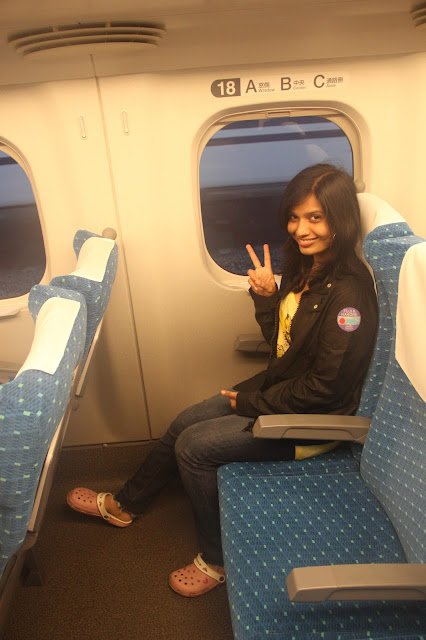Tokyo is one of the most cosmopolitan city in the world but in and around Tokyo you can indulge in travel to beautiful and interesting places too. For tourists one such option is visit to Mount Fuji. The trip would cost you around 14,000 yen per person.
Mount Fuji is without doubt the most famous and the highest mountain peak in Japan.It is a must visit in all travel guides to Japan. Given its popularity there are many tour operators to select from- both private and group tours. The affordable option is to group guided tour as hiring a cab would cost you a bomb ( read a very big bomb !!!).The tours would offer you different combination of tourist places that you may want to visit.We opted for the one with a visit to Hakone and return via Shinkansen.
 |
| Green Love letter |
The ride was fabulous and scenic throughout. The picture above is of a fantastic art work by a Japanese artist.
The first stop on this tour is the Fuji Visitor Centre. Here you find out about the current weather conditions, history, formation, and ecology of Mt. Fuji through exhibits and movies. The second floor observatory deck provides views of Mt. Fuji.
 |
| The 5th Station-full of climbers and tourists |
The bus then takes you till the 5th station,vehicles are not allowed after this point. From here the climbers would set course for a 9 hour trek, up and back, of Mount Fuji. July
and August are the official climbing season. During these two months
the mountain is usually free of snow.It takes around 5-8 hrs to ascent
and 3-4 hrs to descent the mountain from the 5th station.
We were told that the trek is quite famous and not a difficult one. Its for recreation rather than challenge.
We were told that the trek is quite famous and not a difficult one. Its for recreation rather than challenge.
TIP: Our trip was in month of June and during this time Monsoon is set over Japan. The weather can play a spoil sport as cloud cover can completely block the view of mount Fuji from the 5th station.
The weather kept playing hide and seek with us throughout the duration of our stay at the 5th station. It was raining the day we had gone.We were lucky to get glimpses of Fuji San in intervals.Clouds and poor visibility often block the view of Mount Fuji.
It is quite surprising how quickly it turned from foggy to clear and back!
 |
| Really Foggy |
 |
| Same day, same place 15 minutes later.As if the fog was never there |
 |
| Mr Fish, our very interesting tour Guide |
Our next stop was lake Kawaguchiko.
TheFuji five lakes (Fujigoko) are made up of Lake Kawaguchiko,Yamanakako, Saiko, Shojiko and Motosuko at the northern base of Mount Fuji.These five lakes were formed hundreds of years ago by lava flows which dammed up rivers during Mount Fuji's multiple eruptions. Interestingly, three of the lakes, Saiko, Shojiko and Motosuko are still connected with each other by underground waterways.
We cruised for half an hour over the lake.It is one of the best places to view Mount Fuji from a close distance.
TIP : Visibility tends to be better during the colder seasons of the year than in summer, and in the early morning and late evening hours than during the middle of the day.Plan your trip accordingly.It was raining non stop the previous day,luckily it did not rain that day.the visibility was still quite poor.
The tour proceeded to a beatuiful town of Hakone. Hakone is situated in the southwestern part of Kanagawa, and is part of Fuji Hakone Izu National Park. Famous for hot springs, natural beauty and the view of Mount Fuji.
 |
| Celebrating Tanabata :) |
Tanabata "Evening of the seventh" is a Japanese star festival. It celebrates the meeting of the deities Orihime and Hikoboshi (represented by the starsVega and Altair respectively). According to legend, the Milky way separates these lovers, and they are allowed to meet only once a year on the seventh day of the seventh lunar month of the Lunisolar calendar.The date of Tanabata varies by region of the country, but the first festivities begin on July 7.
In Japan, people celebrate the day by writing wishes( in the form of poetry)on small pieces of paper, and hanging them on Bamboo.
In Japan, people celebrate the day by writing wishes( in the form of poetry)on small pieces of paper, and hanging them on Bamboo.
Mt. Komagatake Ropeway -
You can get views of Mt. Fuji, Lake Ashi, Izu Peninsula, Izu Islands, Hakone National Park, while climbing up and down the mountain on an aerial cable way.The visibility was very poor,we could hardly see anything.
 |
| Cableway |
 |
| Lake Ashi from Cableway |
An interesting stop of our tour is Owakudani- area around a crater created during the last eruption of Mount Hakone some 3000 years ago. Today, much of the area is an active volcanic zone where sulfurous fumes.
Because of the steam, Japanese called this Owakudani national park as a “Hell Valley”. Even now, steams come out from the dead volcano. Due to the steams, there is a strong smell of sulphur.
Kuro-tamago -a local specialty of eggs hard-boiled in the hot springs. The boiled eggs turn black and smell slightly sulphuric; consuming the eggs is said to increase longevity. Eating one is said to add seven years to your life. You may eat up to two and a half for up to seventeen and a half years :)
 |
| Black eggs |
 |
| Inside the Shinkansen If you liked the blog,share it with others. |





No comments:
Post a Comment